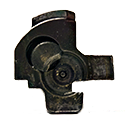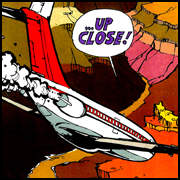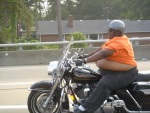|
I was looking through my service manual and found this illustration of my fork.   I had assumed I had a cartridge fork, but it turns out I canít tell looking at the drawing. Iíve never noticed any harshness that Iíve read about from damping rod forks. Why are the internals different from one to the other? I doubt itís a separate function fork.
|
|
|
|

|
| # ? May 16, 2024 18:34 |
|
What kind of weird bike is it? It looks like one side has a cartridge setup and the other, damping rod. It's possible that it only has high/low speed damping on compression and just a piston rod for rebound, I base this purely on the top-out spring being on that side. It may also just have no damping in one fork which is common on very small bikes and the more ornamental Harleys.
|
|
|
|
|
Honda CB300R, which is small and pretty light. Yeah, I thought it looked like what you described, but that sounded like a bizarre setup, so I was left clueless.
|
|
|
|
Ok yeah it's almost certainly cartridge in the one, damping rod/nothing at all in the other one. While I'm here I might as well elaborate on the aforementioned harshness of damping rod forks and why cartridges are functionally superior, for anyone interested. Effort post incoming: Basically what a DR fork does is force fork oil through an orifice to bleed energy out of the system and slow the spring's oscillation. The problem with this system is that the size of the hole has to be a compromise between the demands of low and high speed damping. Low speed damping pertains to the relatively slow, gradual movements in the fork caused by braking, turning, acceleration and rider body movements. High speed damping pertains to the rapid movement of the wheel as it judders and bounces over road irregularities. The faster and heavier the bike is, the further apart these two are. The ideal fork has relatively heavy low speed damping so that the bike feels controlled and stable, but relatively plush high speed damping so that the tyres can snake and slither over bumps without bouncing off or skidding. Unfortunately the damping rod fork is basically the opposite of this; a simple hole offers very low resistance at slow speeds, so the bike feels wobbly and soggy, but it also has an upper flow limit above which the fork effectively hydrolocks because the hole can't possibly flow enough oil in the brief time available, so the bike feels crashy over sudden bumps and vague over ripples. Different brands judge this compromise differently eg Yamaha tend toward plushness, Kawasaki toward stability. Smaller, lighter bikes that don't go very fast can make do with relatively soft low speed damping, so they tend to have supple grippy forks and can use their tyres very effectively even with crude suspension. Faster bikes, like the various midsized 650's, have to lean more toward stability and mass control at high speeds, so you get the crashing sensation more often and the ability to fully exploit the tire is compromised. A cartridge fork effectively consists of the above, but with added one-way valves that are forced open by sudden jolts, which let extra fluid bypass the hole. The force needed to open them is carefully calibrated by stacks of flexing shim washers; the other, related problem of needing to separate the compression and rebound damping is taken care of by having valves in either direction. This whole assembly together is the proverbial cartridge; functionally it's closer to the firm low speed, plush high speed ideal, and the overall effect is a drastic broadening of the bike's ideal operating range aka plusher ride, better grip and improved stability all at once. Slavvy fucked around with this message at 12:36 on Sep 4, 2020 |
|
|
|
|
Anyone here used "Cool Covers"? A neighbor has one on his GS and it seems like it could be a nice thing.
|
|
|
|
Slavvy posted:A cartridge fork effectively consists of the above, but with added one-way valves that are forced open by sudden jolts, which let extra fluid bypass the hole. The force needed to open them is carefully calibrated by stacks of flexing shim washers; the other, related problem of needing to separate the compression and rebound damping is taken care of by having valves in either direction. This whole assembly together is the proverbial cartridge; functionally it's closer to the firm low speed, plush high speed ideal, and the overall effect is a drastic broadening of the bike's ideal operating range aka plusher ride, better grip and improved stability all at once. I assume the calibration varies by bike and is the reason cartridges don't come standard in all forks?
|
|
|
|
SEKCobra posted:Anyone here used "Cool Covers"? A neighbor has one on his GS and it seems like it could be a nice thing. yeah they work alright. I do not recommend paying the $100 or whatever for their fitted, chinese-made covers. instead, buy these one of these, trim it roughly to size, and then just staple it over your cover to your seat pan. you can remove the staples and cover in the winter you can also just use the straps they provide, but I found that to obviously be far less snug and secure
|
|
|
|
right arm posted:yeah they work alright. I do not recommend paying the $100 or whatever for their fitted, chinese-made covers. instead, buy these one of these, trim it roughly to size, and then just staple it over your cover to your seat pan. you can remove the staples and cover in the winter For now I ordered it from china for less than 5 bucks
|
|
|
Renaissance Robot posted:I assume the calibration varies by bike and is the reason cartridges don't come standard in all forks? The shims and valves define the damping qualities of the suspension so yeah every bike is different. They don't come standard on all forks because of $$$.
|
|
|
|
|
SEKCobra posted:For now I ordered it from china for less than 5 bucks I have a Chinese eBay set on my GS, they work fine.
|
|
|
|
SEKCobra posted:For now I ordered it from china for less than 5 bucks noice. they work pretty well. I wouldn't say its drastic, but you definitely feel a bit more venting on your rear end with it
|
|
|
|
I put a set of "cartridge emulators" in my KLR fork and it felt a LOT better up front (because the stock KLR fork is an extremely garbage damping rod).
|
|
|
|
Yeah the KLR isnít even a good damping rod setup to begin with, so emulators would be crazy good on one.
|
|
|
|
this poo poo popped into my head out of nowhere (ok out of alcohol but still) are ADV/dirt tires any more puncture resistant than street tires? riding onto gravel or even pulling over on a dirty shoulder still freaks me out but at this point I think I'm more afraid of running over something nasty and ruining a tire than I am of dumping my nice street bike. I carry a plug kit and everything but I don't want to use it just because I got lost or had to stop and change podcasts. but ADV folks ride over this poo poo all the time so how bad can it be
|
|
|
|
ADV tires aren't any more puncture resistant than street tires, dirt tires mmmmaybe because the lugs are solid chunks of rubber but that's a real slim maybe. You're not going to hurt your street tires riding on gravel. I have a 300' gravel driveway that's currently rutted and hosed up and I ride street bikes over it every day. You absolutely can and will eventually get a puncture if you ride on the shoulder - the last time I had to replace a tire due to a puncture it was from riding on the shoulder to get around a wreck. Some dipshit unpimped his auto by spinning it into the concrete divider between N and S lanes on 75. The highway cops routed traffic over onto the shoulder while the fire department was trying to jaws of life the dude out of his Civic, and I ended up with a random 4" piece of metal in my rear tire. Jazzzzz fucked around with this message at 05:26 on Sep 6, 2020 |
|
|
|
Jazzzzz posted:ADV tires aren't any more puncture resistant than street tires, dirt tires mmmmaybe because the lugs are solid chunks of rubber but that's a real slim maybe. My buddy managed to get a nail through his rear tire the first day out on the trails. Street tires are incredibly tough, sport tires have a ton of very stiff belts that give them a ton of tire rigidity. Nothing you would take a normal car/truck over will puncture your street tires.
|
|
|
|
Slavvy posted:The shims and valves define the damping qualities of the suspension so yeah every bike is different. They don't come standard on all forks because of $$$. I installed gold valves on an RM85 this winter and was bummed to see how similar the outgoing part was. Most of the cost is the valving data though. Two shims stock, 15 going in.   It's for a Team endurance supermoto mini racing series. We're competitive but the CRF150Rs smoke us on power. https://www.cascadiaminimoto.com/ Edit: I mistook this for the pictures thread. Question: How do I avoid endoing under braking? GI Joe jobs fucked around with this message at 17:03 on Sep 6, 2020 |
|
|
|
Renaissance Robot posted:I assume the calibration varies by bike and is the reason cartridges don't come standard in all forks? I was under the impression that most modern bikes, especially ďsportyĒ bikes, have cartridge forks, even if rudimentary and non adjustable. Is that not true?
|
|
|
|
Gullous posted:I installed gold valves on an RM85 this winter and was bummed to see how similar the outgoing part was. Most of the cost is the valving data though. Two shims stock, 15 going in. quote:Edit: I mistook this for the pictures thread. Question: How do I avoid endoing under braking?
|
|
|
Gullous posted:I installed gold valves on an RM85 this winter and was bummed to see how similar the outgoing part was. Most of the cost is the valving data though. Two shims stock, 15 going in. Sit as far back as you can  Toe Rag posted:I was under the impression that most modern bikes, especially “sporty” bikes, have cartridge forks, even if rudimentary and non adjustable. Is that not true? I'd say the upper 50% of the models out there have them. Biggest fastest bikes I can think of that still have damping rods are bandit 1200, all the 650's, almost all cruisers. I've never seen damping rod USD forks (I think Grom has them?) so that's a pretty easy way to tell from the outside. Anyway the smaller and slower the bike is, the less it matters. On an ex250 or whatever it makes almost no difference to the outright speed of the bike at all because you're never stressing the front tyre enough for it to matter.
|
|
|
|
|
Somewhat long question coming in, but the tr;dr version is I completely emptied my brake calipers and replaced the lines and I need to know the best way to get all the air out. Currently "restoring" (making safe to operate) a 1999 gsx-r750, just rebuilt the front master cylinder and replaced what looked like the original lines with stainless steel lines. My plan was to completely disassemble and rebuild the calipers too, so I took them off and drained them of brake fluid, and took one apart before I realized the pistons are 100% stuck in there. Tried using an air compressor and while it did a good job of shooting the remaining brake fluid into my face, the pistons aren't moving. I figured gently caress it I'm just going to hook them up the new lines, get everything bled, and use the hydraulic pressure to get them to move. Just so you know my dumb mistakes along the way, here's what I did: 1) rebuild master cylinder, did a bench bleed and it seems to be working fine 2) hook up the stainless steel lines, kept on pumping the brakes until brake fluid was coming out of the ends 3) hook the EMPTY calipers (first mistake), then try to fill them by just leaving the bleed screws out and pumping, pumping, pumping, pumping (second mistake) 4) remember that oh yeah, you're supposed to pump the brakes, hold the lever closed, open the bleed screw to get air and old fluid out, close the bleed screw, then let go of the lever 5) start doing it the correct way for a while, I'm having to refill the brake fluid reservoir so I know the fluid is getting into the caliper at least 6) eventually fluid starts coming out of the right caliper when bleeding in the correct manner, but the left is still dry 7) remember I have speed bleeders and install them, now nothing is coming out. See a video from STG where I find out you're not supposed to use them when changing lines because they only work if it's mostly air free. put OEM bleed screws back in 8) take off the left caliper and fill it with brake fluid through the hole where the banjo bolt goes. the right caliper was already full from spending too much time doing it manually before. 9) now both calipers emit fluid and air into the hose when bled in the proper procedure, so I go through at least 3 brake fluid reservoirs (high line to low line) worth for each caliper 10) pistons still aren't moving at all, I've been tapping on the calipers with a wrench to try and get the air out and I'm still seeing air in the hose So now I'm wondering what if I should just: 1) keep on doing what I'm doing 2) install the speedbleeders now to make my life easier 3) some other one weird trick method?
|
|
|
|
So your problem is the pistons aren't moving, right? Take the calipers off the bike with the lines etc all hooked up. Put a block of wood between the pistons that DO move, try to find one that holds them in the fully retreated position. Then try pumping the lever and see if you can get them to move. Alternative super filthy method: do the above except unhook the hoses and use a grease gun on the bleed nipple to pack the caliper and force them out. Works great but lots of cleanup.
|
|
|
|
|
Are exhaust wraps bad? Aside from being the calling card of cafe hipsters. I seem to recall hearing concerns about trapping moisture and rusting the exhaust. But Iíve already burned two holes in my riding pants and I canít find an oem or aftermarket heat shield right now.
|
|
|
|
Good news! Right after I posted that the pistons started moving (well some of them at least), but I got distracted by watching which ones were moving vs not moving and let the brake fluid reservoir run empty. And not just empty for a couple squeezes of the lever, I'm pretty sure it was empty for multiple cycles of pump pump pump pump bleed. I went ahead and bled at the master cylinder a few times, now it's back to getting all the air out all over again, goddamn. Did I mention it's 111 degrees today? I don't know if I have any wood that's the right size, I could probably get some small C clamps from habor freight, but I have 12 pistons so that will be interesting. That grease gun method is sounding pretty nice, I can't believe when this is all done I'm just going to pop the pistons out and do it all over again. The pistons are filthy and need to be cleaned though.
|
|
|
|
ought ten posted:Are exhaust wraps bad? Aside from being the calling card of cafe hipsters. I seem to recall hearing concerns about trapping moisture and rusting the exhaust. But Iíve already burned two holes in my riding pants and I canít find an oem or aftermarket heat shield right now. They donít do poo poo as a performance accessory for anything thatís not a racing bike. There are a million anecdotes out there about headers being eaten up by trapped moisture, so take that as you will. The proper thing to do if you use it is to paint the header properly with header paint and cure it before wrapping it. Done properly, the header wonít rust any time soon. And yes, itíll work as a decent heat shield. I had exactly this problem with my DR350. The mounts for the heat shield were hosed up and I couldnít find a decent OEM or aftermarket replacement, so it was easier and cheaper to paint and cure the header and then wrap it. I never burned a hole in my pants again and the radiant heat in my leg was noticeably less. Any time I rode through a puddle, the header stopped steaming in under a minute, so Iím dubious about moisture getting trapped unless youíre in the habit of leaving it out in the rain, riding through a puddle in your driveway right before you park it, or live in the Pacific Northwest or Scotland or somewhere similarly humid.
|
|
|
|
Slavvy posted:
Yup, this works. I had to resort to it after getting the front calipers proper stuck on my transalp. Since then I learned not to be an idiot and rebuild calipers when they get sticky.
|
|
|
|
It's now 113 degrees and I'm over it, that grease gun is sounding really good right now. I was going to take everything apart anyway so it doesn't even sound like the mess will be too bad (famous last words)
|
|
|
|
Planning to put handlebars on the hawk, and move the bars closer to me for less reach. Currently I'd say the grips are kinda "inline" with the forks, and I'd be moving them back 2-3 inches out of line. Will that mess up my handling horribly? I like how it handles now, but want something more upright since it's a general purpose streetbike for me. I know the alternatives are "buy a different bike" and "deal with it" but I really like this hawk and see no reason to toss the baby out with the bathwater.
|
|
|
|
put some apes on it
|
|
|
Coydog posted:Planning to put handlebars on the hawk, and move the bars closer to me for less reach. Currently I'd say the grips are kinda "inline" with the forks, and I'd be moving them back 2-3 inches out of line. Will that mess up my handling horribly? I like how it handles now, but want something more upright since it's a general purpose streetbike for me. I'd be far more concerned with the bars or switches hitting the tank at full lock.
|
|
|
|
|
Slavvy posted:I'd be far more concerned with the bars or switches hitting the tank at full lock. This + cable routing; you'll probably need a new front brake line, and may need new throttle/clutch cables as well. Handling shouldn't be majorly affected, but your seat may suddenly be less comfortable if you end up shifting more weight onto your tailbone b/c of an upright posture.
|
|
|
|
Well in trying to track down the cause of my Goldwings perpetual flat tire, I got the spray bottle out tonight and started spraying all the surfaces. Turns out the tire is leaking at the bead, in a ton of spots. I put a C-clamp on the tire to pull it away from the rim a bit and it looks real crusty in there. If memory serves there is some tire goop you can put on the bead to make the sealing surface actually seal, right? What is that stuff called.
|
|
|
|
Jim Silly-Balls posted:Well in trying to track down the cause of my Goldwings perpetual flat tire, I got the spray bottle out tonight and started spraying all the surfaces. Turns out the tire is leaking at the bead, in a ton of spots. I put a C-clamp on the tire to pull it away from the rim a bit and it looks real crusty in there. uh, bead sealer? https://www.napaonline.com/en/p/BK_7101204
|
|
|
|
If it's that bad, mightn't a tire replacement be in order? Or is it the wheel itself?
|
|
|
|
how old is your tire lol
|
|
|
|
Also if the wheel is crusty or the finish is hosed up and that's what's causing the sealing issue, it's usually pretty cheap to get them media blasted and powder coated at a wheel refinishing joint - provided this is a standard cast wheel and not spoked
|
|
|
|
Yeah the tire is pretty old, I'd be replacing it, but at this point I'm just assuming I'll need the bead sealer (TM) even for a new tire
|
|
|
|
Wtf am I even doing, does this look right? Maybe I ordered the wrong size, maybe I have no business owing even a single wrench. 
|
|
|
|
Why do you have a screen on top of another screen on top of the flyscreen on a loving DR650?!
|
|
|
|
|

|
| # ? May 16, 2024 18:34 |
|
Even with that windscreen I get neck strain riding above 50mph for more than an hour, which isn't something I'd like to do often but it'd be nice to be able to toss on this extension when the need arises. Also, regarding ride comfort, my current helmet is *very loud*, way louder than any other I've ever owned. It's got an internal sun visor and maybe that's why, but I went from a plain HJC medium to a HJC medium with internal visor, and it's just awful. I might try to wear some kind of neck gaiter but it's soo hot out here already. Jack B Nimble fucked around with this message at 01:12 on Sep 14, 2020 |
|
|




























